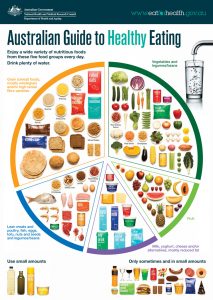A balanced diet is exactly that – a diet which provides us with balance, but let’s dig a bit deeper.
Balance can mean many things, for example: being in a steady position so one does not fall, or it can mean an even distribution of different elements. This can therefore become a little confusing when it comes to balance in our diet. At the end of the day, we want our diet to provide us with balance on many levels which will help to ensure we are providing our bodies with ALL the nutrients we need to remain healthy, keep us fueled for physical activity (such as Cheer) and perform at our best. Read on for more information on balance 😊
A balance of nutrients in and nutrients out
This can be one of our biggest challenges but can also be quite simple. We want to make sure we are getting enough energy to fuel our bodies according to how much energy we use. This also goes for protein, fluids, vitamins and minerals. We need to be aware that our bodies are continuously using different nutrients and therefore these nutrients need to be replaced. Sometimes though, we can also give our bodies too much of one nutrient which is also not a good thing. Therefore, getting the right balance is essential.
As far as getting the right balance of energy, we can usually let our bodies guide us. How are we feeling? Are we feeling hungry? Are our tummies rumbling? Does your stomach feel empty and in need of something to fill it up? Fortunately, our bodies are usually quite good at telling us when and how much energy we need, but at times we can lose the ability to listen. So, remember to sit back and really listen to what your body is telling you.
As far as other nutrients we can usually achieve a good balance if we use the Australian Guide to Healthy eating and the Australian Dietary guidelines to help us decide what to eat each day. Read on for more details on this.
A balance of different foods from each of the food groups
Have you ever heard of the 5 food groups? The five food groups are:
1. Grain (cereal) foods, mostly wholegrain and/or high cereal fibre varieties
2. Vegetables and legumes/beans
3. Lean meats and poultry, fish, eggs, tofu, nuts and seeds and legumes/beans
4. Milk, yoghurt, cheese and/or alternatives, mostly reduced fat
5. Fruit
We should eat mostly from these five food groups each day.
Notice how treats (such as lollies, chocolate, take-away and chips) are not included? This is because we should aim to have these ONLY sometimes and in small amounts. Treat foods should be reserved for special occasions.
While it is never a good idea to get caught up on numbers, a general rule of thumb is to aim for 2 serves of fruit and around 5 serves of vegetables each day. The below picture can also help us understand how much we should be getting from the 5 food groups each day.

A balance of food from within each food group
Each food, within each food group, provides a unique array of nutrients so it is especially important that we try and eat different foods from each food group too. For example, while you may eat apples and bananas one day, try to mix things up and have grapes and pineapple the next day. Eating a variety of foods and trying to eat foods of all colours shapes and sizes each day can be a great way to get started.
Balance for both you and me
Balance will be slightly different for all of us, as we are all different. A good place to look to guide us on what balance means for each of us is the Australian Government Eat for Health website. Check out the below links for information from this website.
Brochure on Healthy Eating for Children:
https://www.eatforhealth.gov.au/sites/default/files/content/The%20Guidelines/n55f_children_brochure.pdf
Brochure on Healthy Eating for Adults:
https://www.eatforhealth.gov.au/sites/default/files/content/The%20Guidelines/n55g_adult_brochure.pdf
Take Home Messages
• Balance can mean many different things
• Try to eat mainly from the 5 food groups each day
• Try to eat different foods from within each of the 5 food groups
• Balance will mean something slightly different for each of us
References
- Australian Dietary Guidelines
https://www.eatforhealth.gov.au/ - Health Direct
https://www.healthdirect.gov.au/balanced-diet - Nutrition Australia
http://www.nutritionaustralia.org/national/resource/healthy-eating-pyramid - The Healthy Food Guide
http://www.health.gov.au/internet/publications/publishing.nsf/Content/nhsc-guidelines~aus-guide-healthy-eating - Better Health Channel
https://www.betterhealth.vic.gov.au/health/healthyliving/Healthy-eating-what-to-put-on-your-plate



